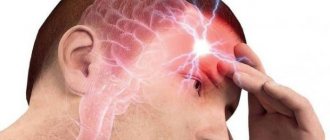Vegetative-vascular dystonia (VSD) - symptoms and treatment
All therapeutic measures for VSD include an impact on etiological factors and pathogenesis links, as well as general strengthening measures.
The impact on the causes of the disease is the desire to normalize lifestyle and eliminate the influence of pathogenic factors on the body.
Which doctor should I contact?
If symptoms of autonomic dysfunction of the nervous system appear, you should consult a neurologist.
Treatment of VSD, based on its pathogenesis , involves:
- normalization of cortical-hypothalamic and hypothalamic-visceral connections with the help of sedatives, tranquilizers, antidepressants and minor neuroleptics [10];
- reducing the activity of the sympathetic-adrenal system and reducing the clinical effects of hypercatecholaminemia through the use of beta-blockers.
When normalizing the afferent connections of the hypothalamus, it is preferable to use high-potential benzodiazepines (alprazolam, lorazepam, phenazepam), but only for a short course, and only to relieve “acute anxiety”, since a dependence syndrome quickly forms, and with prolonged use a withdrawal syndrome may occur. Phenazepam is also practical due to its lower toxicity (2.5 times less toxic than diazepam). Of the antidepressants in modern practice, selective serotonin and norepinephrine reuptake inhibitors (SNRIs) are more often used, since it is the lack of these neurotransmitters that causes the development of psycho-vegetative disorders [19]. Of the “small” antipsychotics, sonapax (thioridazine), eglonil (sulpiride) and teraligen (alimemazine) have found their use in neurological practice, since, having an “antipsychotic” effect, they are not accompanied by pronounced side effects of “larger neuroleptics” - extrapyramidal syndrome, hypersalivation and others [3].
Also, when approaching the treatment of vegetative-vascular dystonia from the point of view of pathogenesis, to correct neurotransmitter disorders, it is necessary to use drugs that restore cerebral metabolism:
- nootropics (glycine, phenibut);
- vitamin preparations - B vitamins (most often in medical practice complex forms are used - combilipen and milgamma - the main participants in the transmission of nerve impulses and myelin synthesis), as well as vitamins with antioxidant effects, especially A, E, C [9];
- ascorbic acid - activates redox reactions, increases the adaptive capabilities of the body [6][14].
To normalize metabolism, metabolic drugs (riboxin, mildronate) are actively used, which also have a microcirculatory, antihypoxic effect, normalizing glucose metabolism and oxygen transport [5].
General restorative measures for VSD include the elimination of alcohol, nicotine, coffee, a healthy diet, normalization of sleep, exercise therapy (physical therapy), and sanatorium-resort treatment [5]. Therapeutic massage, reflexology and water treatments also have a positive effect. The choice of physiotherapeutic treatment is influenced by the type of VSD: electrophoresis with calcium, mesatone and caffeine for vagotonia, electrophoresis with papaverine, aminophylline, bromine and magnesium for sympathicotonia [12].
psychotherapy is also very important in the treatment of VSD , during which the patient is explained the nature of the disease, is convinced that the disease is not life-threatening and has a favorable outcome, and skills are developed to control the psychosomatic manifestations of the disease and adequately respond to them [3 ].
The domestic drug Mexidol (ethylmethylhydroxypyridine succinate) also occupies a strong position in the complex treatment of VSD due to its antioxidant, microcirculatory, metabolic and, importantly, anxiolytic properties. By modulating the activity of receptor complexes, it preserves the structural and functional organization of biomembranes, transports neurotransmitters and improves synaptic transmission [14].
Recently, neurotrophics - cereton (choline alfoscerate), cortexin and cerebrolysin - have been very actively used in the practice of neurologists in the correction of autonomic disorders to strengthen the neurointegrative functional connections of various parts of the nervous system with each other and with underlying organ systems [3].
If cardiovascular syndrome predominates in the VSD clinic, in complex therapy with beta blockers for tachycardias and extrasystoles, potassium and magnesium preparations are used - asparkam (Panagin) and magne B6 (Magnelis) [14]. For vagotonia, use calcium supplements [4].
If headaches, weakness, dizziness and other cerebrovascular disorders against the background of sympathicotonia are expressed during VSD, then vasodilators (for example, myotropic antispasmodics) and vasocorrectors with a vasodilating effect (Cavinton, pentoxifylline) are used, which not only improve cerebral circulation, but also cerebral metabolism by improving oxygen transport, reducing hypoxia and glucose processing [3][9][14]. If cerebrovascular disorders occur within the framework of parasympathicotonia with a decrease in blood pressure, then drugs that stimulate vascular tone (vasobral) are more preferable. Nootropics can be used for the same purpose, as they stimulate the cardiovascular center of the nervous system.
In the case of intracranial hypertension syndrome, which is most often represented in VSD by functional cerebrospinal fluid-dynamic disorders, mild dehydration therapy (acetazolamide, furosemide in combination with potassium supplements) will contribute to improvement. Long-term use of diuretic herbs is also recommended [9].
In case of VSD, chronic foci of infection are treated with concomitant strengthening of the immune system using various immunostimulants (immunal, wobenzym, polyoxidonium) [3].
Symptoms
Autonomic dystonia syndrome can be expressed by different symptoms, which are influenced by etiological factors. Symptoms of vegetative dystonia are manifested by a number of different syndromes, the treatment of which should only be carried out comprehensively.
Cardiovascular syndrome in a patient is manifested by changes in heart rhythm (both tachycardia and bradycardia ), increased blood pressure , changes in skin color (pallor, cyanosis ), hot flashes, and chilliness of the extremities.
Cardiac syndrome is the occurrence of pain of various types or discomfort in the precordial area. The pain is sometimes mistaken for manifestations of angina , but it is not associated with physical activity, lasts longer and does not go away after taking nitroglycerin . Sometimes changes can be detected on an ECG.
Also, with pain, a person suffers from hyperventilation (fast breathing, feeling of lack of air), shortness of breath , which is psychogenic in nature, as well as coughing. Rapid breathing removes too much carbon dioxide from the body. As a result, processes occur in the body leading to the manifestation of muscle spasms and paresthesia in the distal limbs and perioral region. Hyperventilation can cause pre-fainting symptoms in the patient - his vision darkens, weakness and dizziness . But most often, hyperventilation is manifested by pain in the heart, as well as abdominal pain, in which there is a violation of gastrointestinal motility.
If there are disorders of the gastrointestinal tract, the patient's appetite is disturbed and irritable bowel syndrome may occur. Sometimes vomiting, heaviness in the epigastrium, and upset stool appear.
sexual dysfunction may occur , in which men experience erectile dysfunction or ejaculation, and women experience vaginismus or anorgasmia . Another symptom is cystalgia (frequent, painful urination).
Psychovegetative disorders are also expressed by the presence of thermoregulation disorders. They are manifested by hyperthermia, hypothermia, chill syndrome. Hyperthermia can be permanent or paroxysmal.
Speaking about their own illness, patients who have been diagnosed with general psychosomatic syndrome note that the symptoms of the disease are very wide. In other words, sometimes a person feels like absolutely everything hurts. Consequently, the main feature of the symptoms of this disease is the variety of manifestations.
Types of neurocirculatory dystonia
Today, experts define three different types of neurocirculatory dystonia: hypertensive , cardiac , hypotensive . Symptoms of neurocirculatory dystonia of the cardiac type are expressed by insignificant changes in blood pressure. However, in this case, the person suffers from increased heart rate, interruptions in cardiac activity, and shortness of breath. People who suffer from this type of dystonia tend to experience periodic tachycardia, changes in heart rate, and other changes in cardiac activity.
With neurocirculatory dystonia of the hypotensive type, the patient experiences symptoms of heart failure. We are talking about decreased systolic pressure, decreased symptomatic activity and cardiac index. A person suffers from a headache, he gets tired very quickly, feels weak in his muscles, his limbs are cold, his skin turns pale. As a rule, this form of dystonia affects people who have an asthenic physique.
Neurocirculatory dystonia of the hypertensive type is characterized by transient increases in blood pressure. But at the same time, most people do not feel a deterioration in their health. As a result, the disease is diagnosed late, and in most cases this occurs during routine examinations. In addition to increased blood pressure with dystonia of this type, patients experience severe fatigue, headaches, and rapid heartbeat. Considering these symptoms, we can say that the signs of this form of neurocirculatory dystonia are similar to the symptoms of hypertension . Therefore, an accurate diagnosis requires a thorough examination by a specialist and the appointment of further examination.
In addition to these forms of the disease, mixed-type dystonia is also diagnosed, in which the patient experiences fluctuations in blood pressure.
Stages and forms
There are various forms (according to A.M. Vein):
- Constitutional nature;
- Against the background of hormonal changes;
- Psychophysiological nature;
- Against the background of somatic diseases;
- Against the background of occupational diseases;
- For nervousness and mental disorders.
Also, autonomic disorders are often divided into generalized, systemic and local forms. Local forms of autonomic dysfunction are characterized by damage to the peripheral nervous system, and generalized forms are characterized by impaired functioning of suprasegmental autonomic structures.
Autonomic dysfunction syndrome is also characterized by the presence of degrees of severity:
- Lightweight;
- Moderate severity;
- Heavy.
The severity is determined by the severity of tachycardia, the level of blood pressure (hypertension or hypotension), the severity of pain, as well as the frequency of vegetative crises.
Causes
Psychovegetative syndrome manifests itself due to the constitutional characteristics of a person, mental and somatic disorders, under the influence of hereditary factors, as well as as a result of organic damage to the nervous system.
This disease can manifest itself due to hormonal changes in the body, psychosomatic diseases (bronchial asthma, hypertension, etc.), psychophysiological changes (acute and chronic stress), diseases of the nervous system, neuroses, mental disorders, and some occupational diseases.
Such reasons lead to the occurrence of vegetative dystonia, which is often accompanied by panic attacks.
Signs of vegetative-vascular dystonia are varied, in most cases they are a consequence of neurosis. VSD and neurosis are concomitant disorders; in addition, patients with VSD may experience mental disorders. Complex therapy allows you to eliminate the physiological and mental manifestations of the disease.
Effective treatment of neuroses and mental disorders in VSD is carried out by neurologists, psychotherapists, exercise therapy instructors and other specialists at the Yusupov Hospital, who use sound and safe methods of therapy.
This syndrome often occurs as a result of the influence of mental or somatic disorders that a person already has. As a rule, autonomic disorders are a consequence of secondary dysfunction of the nervous, humoral and autonomic regulation of vascular wall tone in pathological conditions of various organs and systems.
Somatic pathologies include arterial hypertension, coronary heart disease, and diseases of the gastrointestinal tract. Mental disorders include depressive disorders and panic attacks.
Also, the causes of autonomic disorders include:
- Disrupted work and rest schedule;
- Excess body weight, obesity I, II and III degrees;
- Reduced physical activity during the day (sedentary lifestyle, which is especially typical for office workers);
- Spending long periods of time at the computer/TV/electronic gadgets;
- Alcohol abuse;
- Long history of smoking;
- Insomnia (insomnia), dyssomnia (sleep disorders);
- Chronic diseases in the stage of decompensation;
- Chronic infectious processes;
- Immunodeficiency conditions;
- Chronic stress, especially if it is present both at work and at home;
- Taking narcotic, psychostimulant or toxic drugs.
The course of the disease depending on age
To diagnose psychovegetative syndrome, a comprehensive examination is required. First of all, the doctor must exclude all somatic diseases that manifest themselves in a similar way.
High-quality diagnostics requires consultation with several doctors of different profiles. Interviewing the patient is considered very important. The doctor is obliged to ask him about all the sensations and find out all the subtleties of the manifestation of the disease.
During the examination, an electrocardiogram, computed tomography, MRI, and vascular Doppler sonography are often prescribed.
Autonomic dysfunction syndrome is quite widespread: it occurs in more than 30% of patients who seek medical help. In children, adolescents and young adults, the incidence of this pathology is up to 30%. This is explained by hormonal changes that occur in a young body.
Helpful information
The spread of SVD among schoolchildren is due to the fact that during this period changes in the child’s hormonal levels occur, and all life processes intensify.
Also, the educational load, huge information flows and a sedentary lifestyle have a significant impact on the incidence of students.
Diagnosis of autonomic dysfunction syndrome has significant difficulties associated with the lack of a clearly defined etiology of the disease and objective research methods. A patient seeking medical help should be carefully examined to identify the primary causes of certain symptoms.
Diagnostics is based on the following data:
- The patient’s complaints, the dynamics of their development;
- History of the disease (when the symptoms appeared, how they began, how they changed, their dynamics);
- Compounded hereditary history (presence of cardiovascular diseases or diabetes mellitus in parents under the age of 55 years);
- Determination of blood pressure (at rest and during functional tests) and heart rate;
- Electrocardiography and echocardiography to exclude pathology of the cardiovascular system;
- General and biochemical blood test to exclude pathologies of other organs;
- General urine analysis;
- Chest X-ray and spirometry for pronounced symptoms from the respiratory system;
- Bicycle ergometry allows you to adequately assess your heart rhythm.
Of particular importance is differential diagnosis with other diseases.








